There can be no doubt that the Mycenaean civilization of Bronze Age Greece was destroyed in the course of the twelfth century B.C. In the midst of widespread disturbances in the entire Eastern Mediterranean, Mycenaean citadels and villages alike were destroyed and the population declined to an estimated one-quarter of its former size. In seeking a cause for the destruction, modern scholars followed the Classical Greeks who preserved a memory of their past which included an Age of Heroes—an echo of the Mycenaean period—and a Trojan War succeeded by a time of troubles during which the Dorian Invasion occurred. Invaders, then, could be cited as the agents of the calamities.
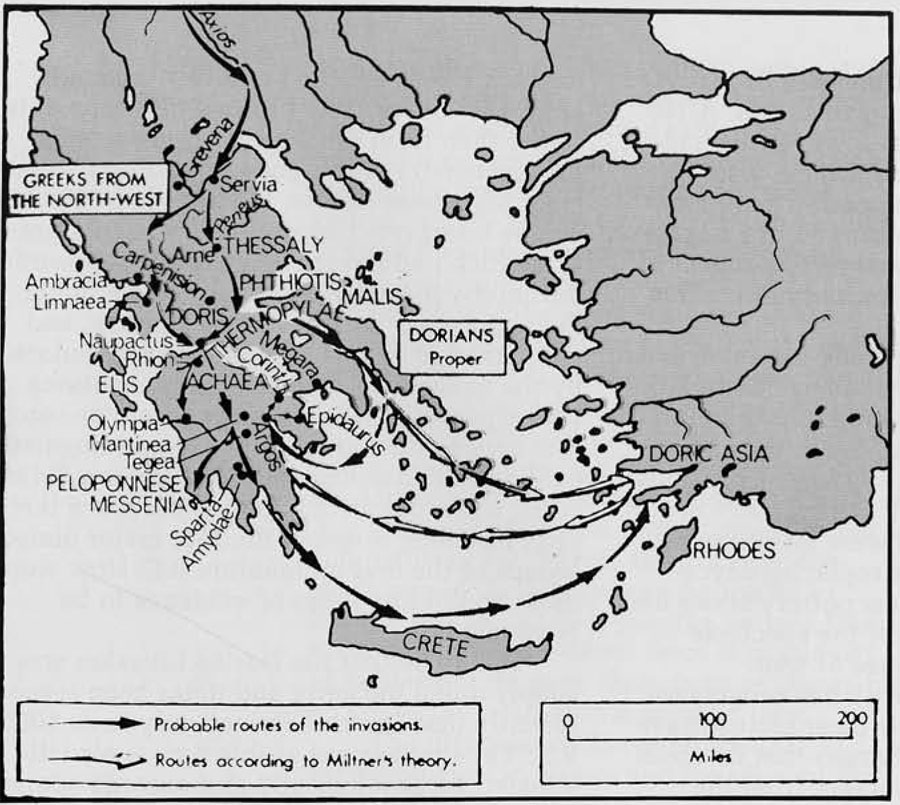
According to Cohn McEvedy,
“About 1200 the Achaean Greek and Hittite kingdoms were overthrown by migrating barbarians. This movement started in the south-east of the Balkans with two peoples, the Dorian Greeks and the Phrygians. The Dorians, the northernmost of the Greek tribes, broke into the peninsula and methodically sacked the Achaean strongholds; they then took to the sea and meted out the same treatment in Crete and Rhodes.”
The modern theory of a Dorian Invasion into Greece was rooted in nineteenth century linguistic evidence which seemed to support a wave theory of migration. Classical Greeks themselves recognized that their language had major branches or dialects and it was argued that each form of Greek could be explained, historically, as being brought to Greece by subsequent waves of immigrants, The first Greek tongue of the mainland was brought by the earliest Indo-Europeans to reach Greece toward the end of the third millennium B.C. During the Middle Bronze Age these newcomers established their position of increasing strength and wealth which led to the flourishing civilization of the Late Bronze Age known as the Mycenaean civilization. After some four hundred years, however, the culture of these early Greek speakers was destroyed and culprits seemed to he at hand in the Dorians who, according to this linguistic theory, brought the most recent dialect of Greek at the close of the second millennium B.C.
Newcomers, it is generally believed, make their presence known by some characteristic artefacts or institutions, and archaeological data that accumulated rapidly in the early decades of the twentieth century also seemed to support the theory of a Dorian wave of invasion. To the Dorians were attributed the appearance of cist tombs replacing Mycenaean chamber tombs, new pottery styles and shapes, the introduction of the spectacle fibula and the increased use of iron.
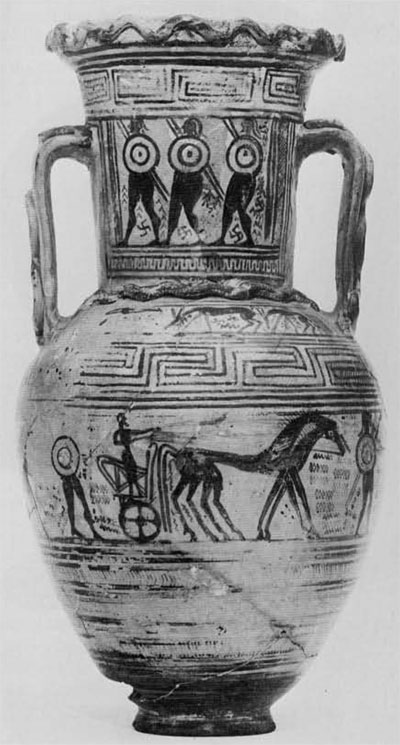
Museum Object Number(s): 30-33-133
As archaeological work has progressed, however, the edges of this clear picture have been blurred: physical changes that do occur in the aftermath of destruction from the thirteenth through the tenth centuries now appear to derive from internal developments rather than from the arrival of newcomers. Protogeometric and Geometric pottery stem from Mycenaean roots; the use of cist tombs can be interpreted as a revival of an old practice which had never completely disappeared during the Bronze Age; the spectacle fibula did not appear until the ninth century; and the spread of iron technology was stimulated by the collapse of Bronze Age civilizations. Consequently, there developed a major conflict between the archaeological and linguistic evidence: archaeologically the Dorians did not exist, while linguistically they did since their form of Greek is one of the four major dialect groups of the first millennium B.C. How were these conflicting types of evidence to be reconciled?
It may be that the Dorian Invasion was simply dated too early and it has been argued recently that Dorians arrived only in ca 1000 B.C. Yet a movement at this time is also ill-attested archaeologically and accords poorly with traditional evidence which combines the Dorian entrance and the end of the Bronze Age. If we move backward rather than forward in time, we reach the division between the Middle and Late Bronze periods in approximately 1600 B.C. which has been held to mark the entrance of newcomers to the Greek mainland. Perhaps these are our Dorians. While the shaft graves as well as increasing sophistication of culture do separate the two periods, there is no widespread destruction to suggest the incursion of people differing from the Middle Bronze Age population. And, in fact, the features which typify the Mycenaean civilization of the Late Bronze Age grew out of earlier, more primitive characteristics of the Middle Bronze Age: the shaft graves themselves can be traced to Middle Bronze grave types; the pottery traditions continue unbroken; there is continuity of settlement. In sum, there is no evidence for a Dorian Invasion at this point in time.
The discrepancy between the lack of archaeological evidence and the view of the past preserved by Classical Greeks reached such an impasse that archaeologists began to ask with V. R. d’A. Desborough:
“If [invaders] remained and settled, why have they left no trace? Can one really suppose that they were so primitive as to leave no evidence, whether in some new custom or at the very least in some new artefact? If they moved on, where did they go to? If they went back, why did they do so, leaving the good land which they could have occupied?”
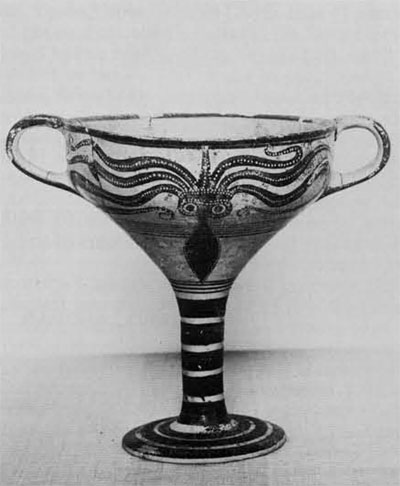
Museum Object Number(s): MS5701
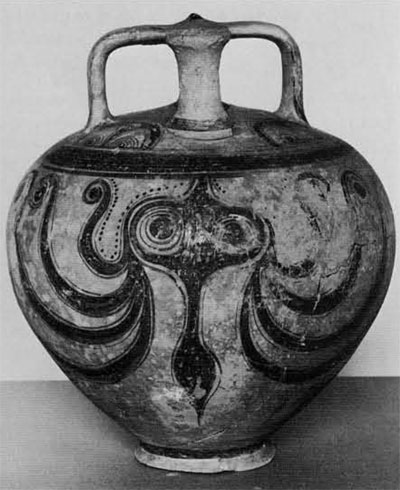
There remains one cultural break into which Dorians may be fitted: the close of the Early Bronze Age when the earliest Indo-Europeans reached Greece bringing protoGreek and destruction, followed by rebuilding which witnessed different ceramic and architectural conventions. But these proto-Greeks are generally equated, linguistically, with the “Achaeans” or Greeks of the Heroic Age. It is an impossible task to insert the Doric-speaking Greeks into the picture, given the standard interpretation of the Greek dialects and their formation. We must ask, therefore, whether we have been in error regarding the development of the Greek language in assuming that the various dialects were formed outside Greece and carried to the mainland from elsewhere. Dr. John Chadwick has suggested that the interpretation needs alteration, He has demonstrated that the wave theory of invasion is based on the assumption that Greek was formed outside Greece but that this assumption may have no foundation in fact.
When the first Indo-Europeans arrived in Greece near the end of the third millennium, there began a gradual generation of both the Greek language and a distinctive culture during the course of the Middle Bronze Age. The Linear B tablets are the final products of the development of Mycenaean Greek in the Late Bronze Age, while the Mycenaean civilization is the culmination of cultural fusion and growth. This civilization owed much to the Minoan culture of the island of Crete and it is certain that influences were felt in matters of language as well as in other aspects of life.
Accordingly, Dr. Chadwick has argued that the form of Mycenaean Greek known from the Linear B tablets arose from the imposition of a Minoan linguistic superstructure upon the Greek language of the mainland. The tablets, then, reveal a combination of non-Greek Minoan features and characteristics of the Greek tongue. If this is true, Mycenaean Greek can be understood as administrative Greek fashioned by a Minoan civil service for use by mainland rulers of large and complex kingdoms, rulers whose native language corresponded only partially with the language of the tablets.
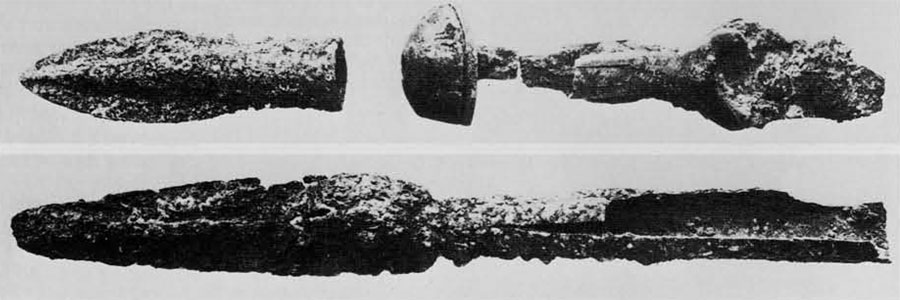
But what sort of Greek was spoken by the common people? Certain modern scholars have detected the presence of two dialects in the Linear B tablets and Dr. Chadwick suggests that one dialect was proto-Doric. In fact, then, Dorians were present in Greece from at least the end of the Middle Bronze Age and, as the archaeological evidence described above suggests, from the end of the Early Bronze Age.
Such an interpretation explains a number of puzzles. If the common folk of the Mycenaean kingdoms were Doric-speakers, it is likely that they served as soldiers at the time of the Mycenaean take-over at Knossos in the fifteenth century and, gradually entrenching themselves, they increased in number and strength. Anthropological evidence supports this conclusion: the inhabitants in the west of the island who are more brachycephalic or broad-headed than other early Cretan inhabitants have been identified as Dorians. From 1500 B.C. onwards there is evidence of an increase in this brachycephalic element in proportion to the less broad-headed, native inhabitants of the Cretan population.
Consequently the difficulty of locating data for the arrival on Crete of large numbers of Dorians after the collapse of the Mycenaean civilization disappears, and one can understand the passages in Homer which imply the presence of Dorians on Crete before the end of the Bronze Age. Similarly, the necessity of picturing a Dorian Invasion of the Peloponnese is eliminated, and the absence of evidence for an incursion of a wave of Greeks at the close of the Mycenaean era is no longer troublesome.
Furthermore, the new interpretation has important ramifications for our understanding of the Classical period. Previously one could only wonder at the degree of similarity between various city-states which, apparently, had undergone dissimilar patterns of formation, Why, for example, was it that Athens, which witnessed continuous habitation from the Late Bronze to the Classical period, had an institutional structure similar to that of Sparta where settlement was broken by, presumably, the arrival of Dorians? Is it likely that the political structure of a community with firm Mycenaean roots would be almost identical to that of a recently-established Dorian settlement? Plainly the answer is no.
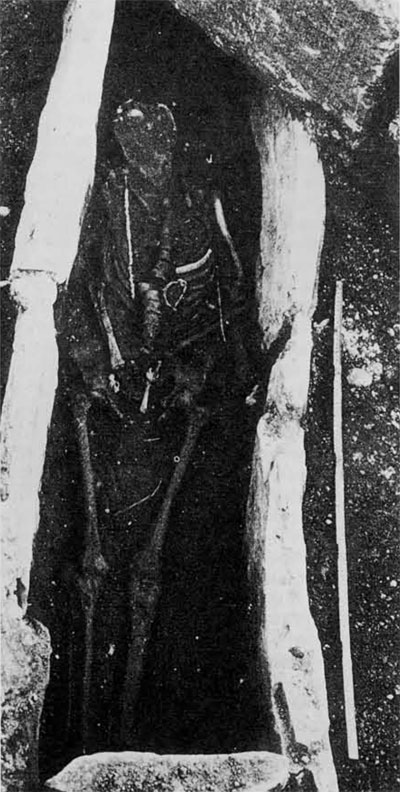
Dr. Chadwick’s thesis provides a satisfactory solution: when the administrative structure of the Mycenaean kingdoms was broken throughout Greece, lesser officials assumed control over more localized settlements. This break occurred in Attica as well as in the Argolid or Laconia. Both “Mycenaeans,” that is speakers of official Greek, and Dorians, the common folk of the kingdoms, witnessed the altered situation and, hence, institutions in their new forms were incorporated into the post-Mycenaean Greek world everywhere.
There is only one immediate difficulty with this view of the Dorians: every reader of Herodotus and Thucydides knows of the Dorian Invasion and the Return of the descendants of Herakles. Sixty years after the Trojan War, Thucydides recounts, the Boeotians, on being expelled from Thessaly, entered Boeotia and twenty years later the Dorians entered the Peloponnese (1.12). The entrance, according to Herodotus (IX.26), was one hundred years after a first attempt to enter had failed when Hyllus, a son of Herakles, was defeated in hand-to-hand combat by the Arcadian hero Echemus. Adhering to an agreement by which they would enter only if their hero were victorious, the Dorians withdrew. Not only the historians but also the poets knew of the Dorians and the Herakleids: Homer sang of Dorians in Crete (Od. XIX.177) and believed that the Rhodians at Troy were commanded by Tlepolemus, another son of Herakles, and that the contingent of Casos, Carpathos, Nisyros and Cos was led by two sons of the Doric Thessalus (IL 11.653 f„ 676f.), also a son of Herakles. Tyrtaeus exhorted the Spartans as the line of Herakles and described the city of Lacedaemon as a gift from Zeus to the Herakleids (fr. 11 and 2). Pindar, too, alluded to a Dorian Invasion in his first Pythian ❑de (1.65 f.): “they took Amyklai, issuing forth from Pindus.” Let us examine these references in more detail to ascertain the firmness of their foundation.
The linguistic evidence of a “Return of the Herakleids” lies in the interpretation of the word which can have the meaning of “come back” or “return.” Its primary meaning, however, is “to go” or “to come down” and this meaning is at least as logical as one which suggests a return, Although there is little evidence for a “Return,” this may not be a serious hindrance to a Dorian Invasion theory itself, since even proponents of the thesis admit that “the Herakleidai did not belong to the Doric stock proper”; they were rather a noble family that merely accompanied the Dorians into the Peloponnese. The fact that Herakles himself is firmly rooted in Theban and Tirynthian tradition, whose point of reference is the Heroic Age, may be a more important consideration, as we shall see.

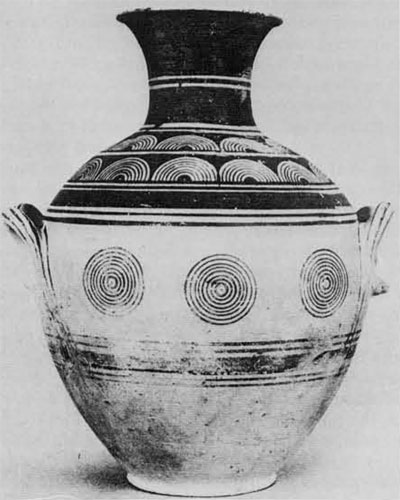
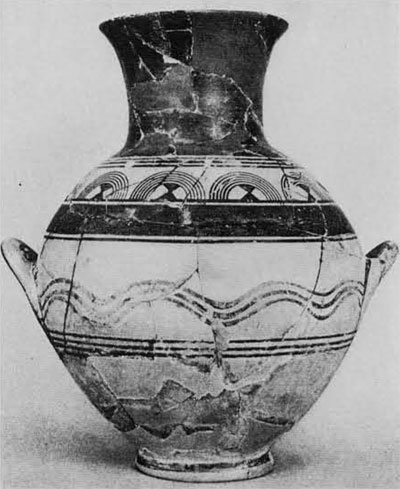
Moreover, the sources disagree with one another: Thucydides, for example, disagrees with the Homeric account and at 1.9 takes Herodotus’ version “with a grain of salt.” Herodotus‘ account of the Dorians’ wanderings is not followed by the other sources. And the sources are at odds concerning the interrelationship between the various branches of Doric-speakers. But historians and poets have one feature in common in that they all associate Dorians, in some way, with the Heroic Age: Herakles belongs to the “Achaean” world; the two passages in Homer suggest the possibility of early Dorian settlements in Crete and in the Dodecanese before the end of the Bronze Age; Herodotus sets Herakleids in a Mycenaean context and Thucydides places all of the post-Trojan War invasion in a world of “stasis (or discord) in the cities.” In other words, we have come to the same conclusion to which archaeological and linguistic evidence has led: the Dorians themselves belong to the mainstream of Late Bronze Age civilization on the Greek mainland.
Why, then, did the literary sources—perhaps going back to folk memory of the Dorians—find it necessary or desirable to fabricate a tradition of late entrance into the mainland if Dorians had been present from the end of the Early Bronze Age? If their presence had been acknowledged they would have shared in the glory of the Heroic Age. But would they have shared the glory? Dorians were not among the lords and heroes of that society but rather held far more lowly positions. Instead of participating as subjects in the world of heroes, it would be preferable to be remembered as destroyers of that old world and creators of the new.
